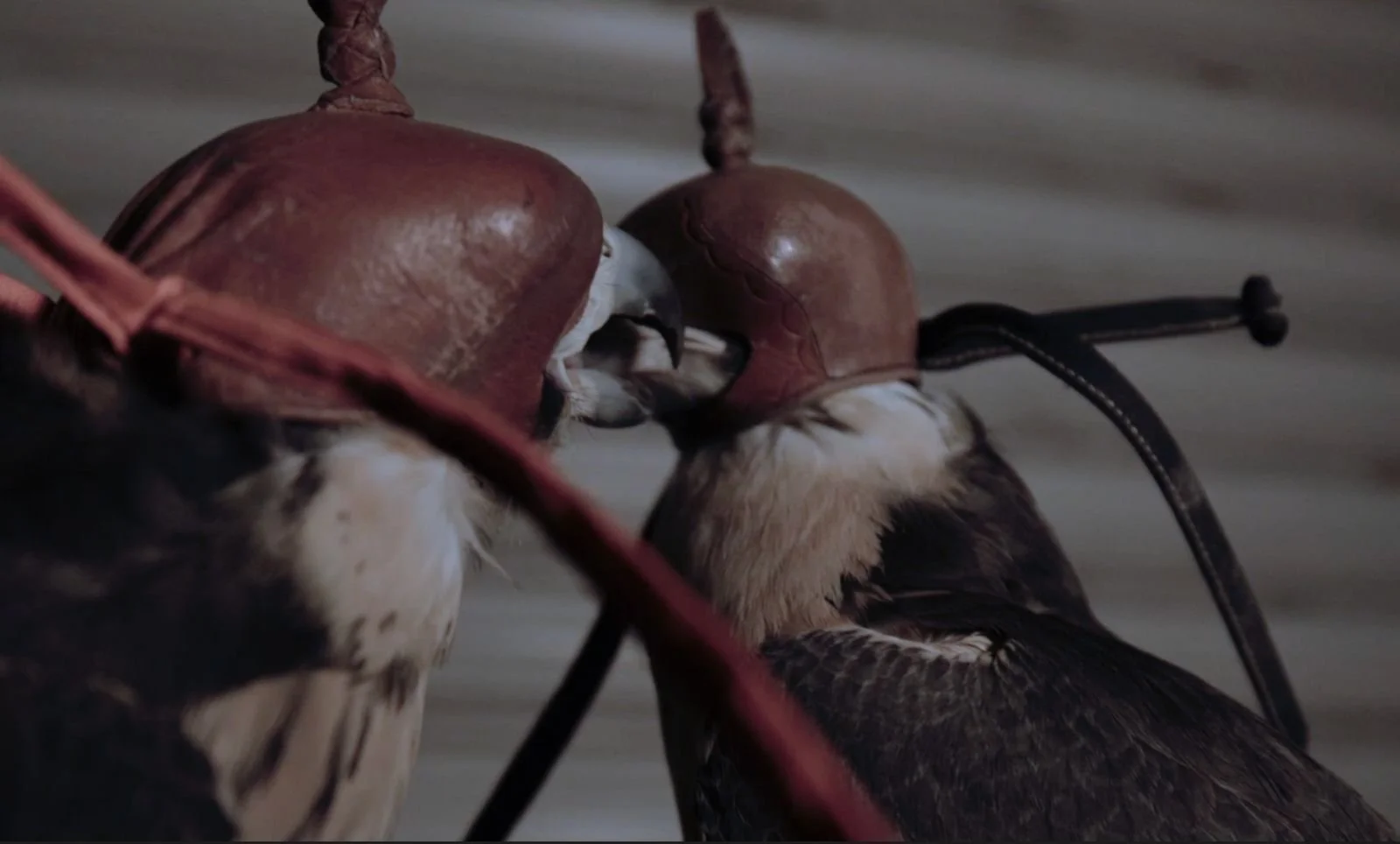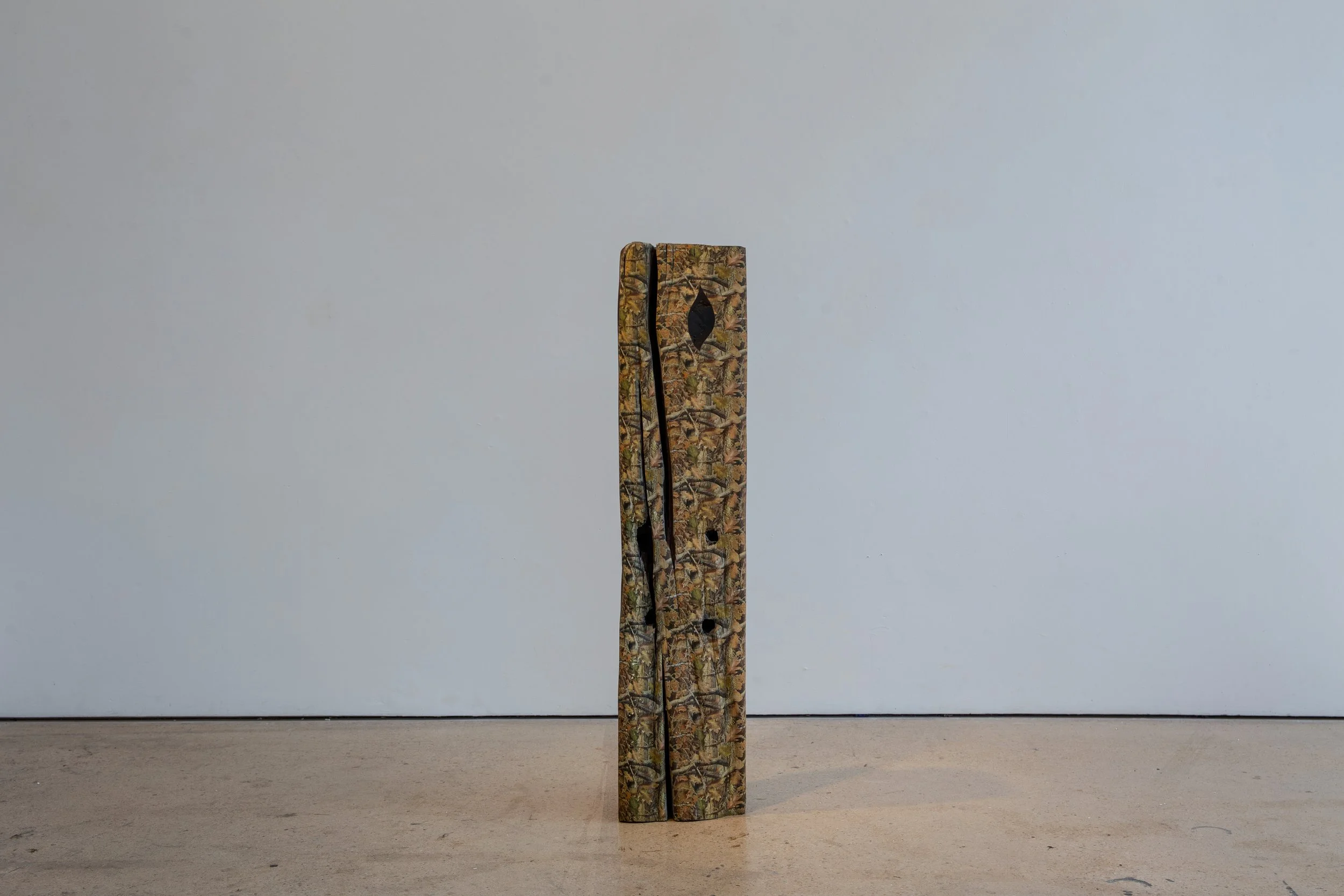Hide by Conor Ackhurst
A tree is a singular object. A forest is an abstraction, we experience it as an environment, an atmosphere, a system. A forest is a concept that emerges from multiplicity. It exists not just as a sum of its parts, but as something more: a space shaped by density, depth, concealment, and movement.
In HIDE, three wooden forms stand in the space, their surfaces wrapped in Realtree camouflage through the process of hydro-dipping. Their material anchors them to the natural world, but their surface is pure simulation. A tree wrapped in an image of trees. A real thing made unreal.
Camouflage functions as a flattening of the natural world, a pattern designed to dissolve boundaries. In a hunting context, it allows a body to disappear into an environment, creating a seamless relationship between self and landscape. But symbolically, camouflage occupies a more ambiguous space, entwined with power, deception, and strategies of adaptive disguise. From the courtly stag hunts of the Renaissance to the optical experiments of modernist abstraction, the aesthetics of concealment have long mirrored shifting ideals of vision, mastery, and control.
The sculptures form a fragmented, artificial forest. Their surfaces suggest multiplication, one tree becomes many, the space between them filled by the image of an environment. The hydro-dip process itself is rooted in commercial hunting culture, where camouflage is not just a tool but an aesthetic applied to guns, clothing, vehicles, and bodies. A pre-printed hydrographic film floats on water, objects are submerged, patterns stretch and conform. A skin of images replaces the surface of things. The result is a visual veneer, one that erases the uniqueness of the object beneath it, making it part of a larger system of concealment.
A video shot across Sussex and Mexico City traces two converging scenes. In one, filmed at Grange Park Opera House with cinematographer Joey Knox, a bowhunter moves slowly through the architecture of spectatorship: from the stage, across rows of empty seats, and into the upper gallery. The space becomes a suspended theatre of pursuit, where the boundary between observer and observed begins to blur.
Cut between this is another sequence, filmed in Mexico City with the help of Diego Gaxiola, where hawks and falcons perch on the sculptural structures. Their presence reframes the forms not as cover, but as elevated vantage points, platforms from which to scan, wait, and hold. These acts of stillness unsettle distinctions between concealment and visibility, action and latency.
The video resists resolution. Both hunter and bird inhabit roles shaped by predation, bound by a charged and embodied form of attention. The sculptures become studies in shifting vantage: structures through which vision is organised and withheld. Platforms here are not merely physical but conceptual, sites that structure perception and hold tension. Music by Ivo Pacheco sustains this atmosphere, amplifying a suspended state where potential remains unspent.
A one-way privacy window film applied to the gallery windows introduces a subtle intervention into the exhibition architecture. Shifting the balance of light and sight, the privacy film creates a disjunction between what can be seen and what remains hidden. It complicates the relationship between viewer and viewed, echoing the dynamics of the hunting hide, where vision is both a privilege and a weapon. Sight lines are no longer reciprocal, they are uncertain, contingent, and asymmetrical.
Typically found in corporate and security environments, this type of film mimics transparency while undermining it. The glass maintains the appearance of openness, but its function is reversed, visibility becomes selective, directionally controlled. What looks like connection becomes surveillance, what resembles clarity conceals its own obstructions. The material introduces a quiet unease, an architecture that gestures toward access while staging withdrawal.
installation SVA 2025
Developed during a residency in Mexico, HIDE is a continuation of Conor Ackhurst’s ongoing investigation into simulation, constructed environments, and the uneasy friction between digital and physical realities. In this work, camouflage is not only a tool of concealment, but a political and aesthetic force, one that dissolves, distorts, and reorganises our relationship to nature, perception, and power.
Stroud Valleys Artspace, 4 John Street, Stroud United Kingdom, curated by Hugh Allan

